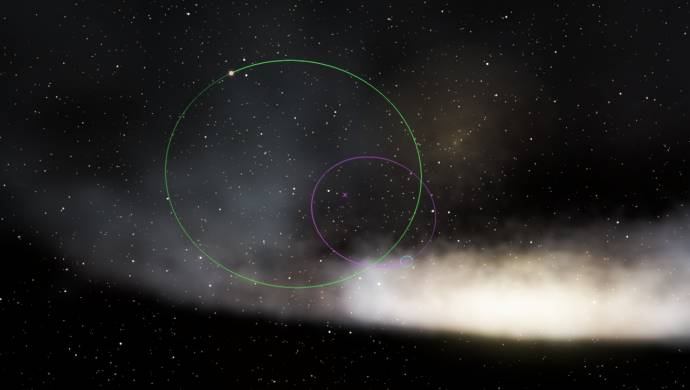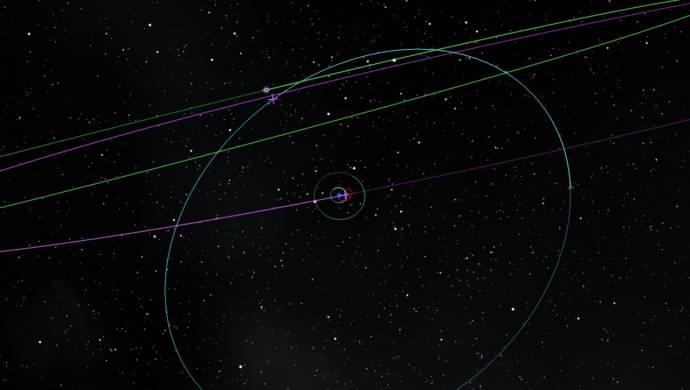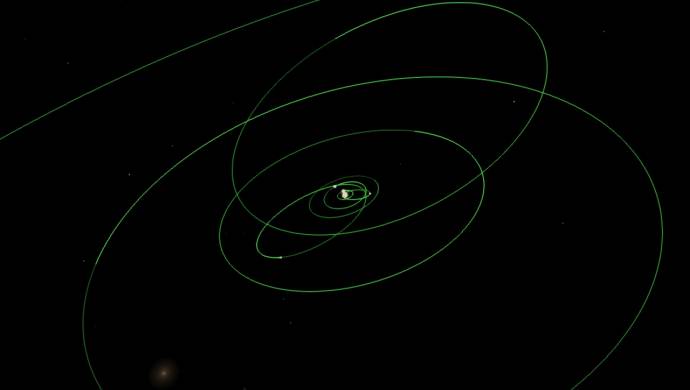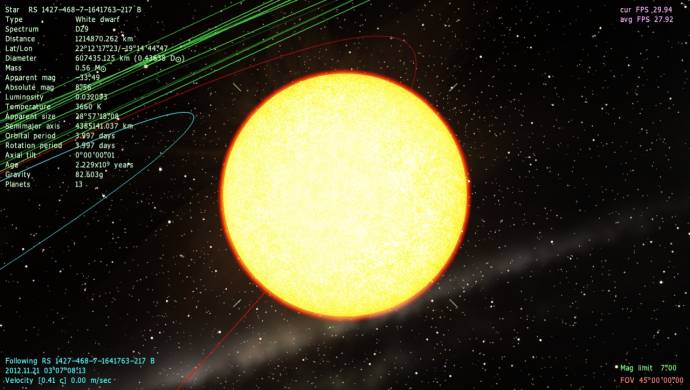|
Space anomalies
|
|
| HarbingerDawn | Date: Thursday, 11.10.2012, 17:39 | Message # 31 |
 Cosmic Curator
Group: Administrators
 United States
United States
Messages: 8717
Status: Offline
| It would probably still be main sequence at that age, but within 2 billion years after that it would definitely be a red giant. As you go down in mass, the lifespan of the star increases dramatically. For example, a star with 0.82 MSol could live for 20 billion years. For a mass of 0.1, the star could live for over a trillion years.
All forum users, please read this!
My SE mods and addons
Phenom II X6 1090T 3.2 GHz, 16 GB DDR3 RAM, GTX 970 3584 MB VRAM
|
| |
| |
| SpaceEngineer | Date: Thursday, 11.10.2012, 18:22 | Message # 32 |
 Author of Space Engine
Group: Administrators
 Russian Federation
Russian Federation
Messages: 4800
Status: Offline
| Quote (smjjames) The wrong age thing tends to come up more often in binaries and multilples. Maybe we should do a survey of giant stars (apart from the odd TinyGiants, which might or might not be a bug) to see if there are any with wrong ages?
Yes, the bug was in the function that generates multiple star system. The variable 'LifeTime' was overwritten by every star generated, so it might end up with billion years if last generated star was yellow or red dwarf (as in those system). After that, the actual age of system is calculated as random portion of LifeTime. The fixed code computes LifeTime as minimum of life times of all stars in the system.
Quote (smjjames) Anyways, a related question, a G7 dwarf with a mass of 0.93988 is 11.1 billion years old. Shouldn't that one be on it's way to becoming a red giant?
Is this star a catalog star (HD #### or HIP ####)? The "tiny giant" bug is only for catalog stars, because some stars in the catalog have incorrect luminosity or spectral class.

|
| |
| |
| smjjames | Date: Thursday, 11.10.2012, 18:57 | Message # 33 |
|
World Builder
Group: Users
 United States
United States
Messages: 913
Status: Offline
| Quote (SpaceEngineer) Quote (smjjames)
Anyways, a related question, a G7 dwarf with a mass of 0.93988 is 11.1 billion years old. Shouldn't that one be on it's way to becoming a red giant?
Is this star a catalog star (HD #### or HIP ####)? The "tiny giant" bug is only for catalog stars, because some stars in the catalog have incorrect luminosity or spectral class.
It's a procedural star in a distant catalog galaxy. Anyways, by tiny giant, I mean those stars that get labelled yellow giant (I've only seen that one) but are of a much smaller diameter and I've seen them with procedural stars, however they're rare.
Edit: This post is an example of what I mean by TinyGiant.
Also, I've found in the same galaxy a rare blue main sequence star (in a triple star system) with a life bearing planet and is 342 million years old. Probably the same bug as the one above as the other stars are an A6 and F4.
Quote (SpaceEngineer) Quote (smjjames)
The wrong age thing tends to come up more often in binaries and multilples. Maybe we should do a survey of giant stars (apart from the odd TinyGiants, which might or might not be a bug) to see if there are any with wrong ages?
Yes, the bug was in the function that generates multiple star system. The variable 'LifeTime' was overwritten by every star generated, so it might end up with billion years if last generated star was yellow or red dwarf (as in those system). After that, the actual age of system is calculated as random portion of LifeTime. The fixed code computes LifeTime as minimum of life times of all stars in the system.
What about white dwarfs, neutron stars, and black holes? A newly formed neutron star or black hole that came from a supernova that happens just now would obviously be young.

Edited by smjjames - Thursday, 11.10.2012, 19:05 |
| |
| |
| apenpaap | Date: Thursday, 11.10.2012, 19:24 | Message # 34 |
 World Builder
Group: Users
 Antarctica
Antarctica
Messages: 1063
Status: Offline
| I'm pretty sure stellar remnants' ages are counted from the birth of the star they used to be, not their own formation. So they wouldn;'t be that young even if newly formed.
I occasionally stream at http://www.twitch.tv/magistermystax. Sometimes SE, sometimes other games.
|
| |
| |
| smjjames | Date: Wednesday, 24.10.2012, 21:54 | Message # 35 |
|
World Builder
Group: Users
 United States
United States
Messages: 913
Status: Offline
| We have a second octuple system!! This time, in a distant galaxy. This one has several brown dwarfs, a G and a K class star, a white dwarf, a neutron star, and a bugged (same mass as the K class :P) red dwarf.
Code Place "Octuple star G5 V"
{
Body "RS 9101-1574-7-1003083-2"
Parent ""
Pos (-0.002902008139880161, 0.003341539327303824, 0.004465188314513663)
Rot (0.9178971914833783, -0.3155381680957446, -0.2128819093636032, 0.1121681907111589)
Date "2012.10.24 20:51:06.21"
Vel 0.00062869262
Mode 1
}



|
| |
| |
| Quontex | Date: Monday, 29.10.2012, 03:46 | Message # 36 |
 Explorer
Group: Users
 Australia
Australia
Messages: 155
Status: Offline
| Since this is a "Named" star I am guessing at least someone found this, You most likely guessed from the title I have found Gase giant with an ice giant moon.
Planet name: Tseen Ke 2
My next project is to find a ice giant or gase giant moon for a terrestial planet, since this and moons with rings is possible.

Edited by Quontex - Monday, 29.10.2012, 03:49 |
| |
| |
| HarbingerDawn | Date: Monday, 29.10.2012, 04:00 | Message # 37 |
 Cosmic Curator
Group: Administrators
 United States
United States
Messages: 8717
Status: Offline
| Quontex, posts about ice giant moons and such generally go here.
And it is impossible to find an ice giant moon for a terrestrial planet, since a moon cannot be more massive than its parent object. If those two objects were together, then the ice giant would be the planet and the terrestrial world would be the moon.
All forum users, please read this!
My SE mods and addons
Phenom II X6 1090T 3.2 GHz, 16 GB DDR3 RAM, GTX 970 3584 MB VRAM
|
| |
| |
| smjjames | Date: Saturday, 03.11.2012, 16:38 | Message # 38 |
|
World Builder
Group: Users
 United States
United States
Messages: 913
Status: Offline
| The elliptical orbits themselves aren't the anomaly, it's that this is a pretty chaotic system for SE. Given that the system is 8 billion years old, it's probably going through a late chaotic phase due to interactions between planets or a near encounter with another star.


|
| |
| |
| Frostbreath | Date: Sunday, 18.11.2012, 21:59 | Message # 39 |
 Space Pilot
Group: Translators
 Netherlands
Netherlands
Messages: 118
Status: Offline
| 
I posted it at the image dump earlier, but placing it here makes more sense I guess.
Which is the planet and which is it's moon?
Amateur astronomer. Owner of a Celestron C8 telescope and, of course, Space Engine. Translator for Dutch.

Edited by Frostbreath - Sunday, 18.11.2012, 22:25 |
| |
| |
| DoctorOfSpace | Date: Sunday, 18.11.2012, 22:19 | Message # 40 |
 Galaxy Architect
Group: Global Moderators
 Pirate
Pirate
Messages: 3600
Status: Offline
| Quote (Frostbreath) Which is the planet and which is it's moon?
Neither and both. 
Intel Core i7-5820K 4.2GHz 6-Core Processor
G.Skill Ripjaws V Series 32GB (4 x 8GB) DDR4-2400 Memory
EVGA GTX 980 Ti SC 6GB
|
| |
| |
| Frostbreath | Date: Sunday, 18.11.2012, 22:24 | Message # 41 |
 Space Pilot
Group: Translators
 Netherlands
Netherlands
Messages: 118
Status: Offline
| Quote (DoctorOfSpace) Neither and both.
I see what you did there!
According to Space Engine, the ringed body is the moon. It's diameter is 1.3 times that of the Earth. The planet's diameter is 1.4 times the size of the Earth... So we have a ringed moon orbiting a planet almost the same size on a close distance and that moon had life as well!
Amateur astronomer. Owner of a Celestron C8 telescope and, of course, Space Engine. Translator for Dutch.

|
| |
| |
| Aerospacefag | Date: Sunday, 18.11.2012, 22:53 | Message # 42 |
 Pioneer
Group: Users
 Russian Federation
Russian Federation
Messages: 401
Status: Offline
| Frostbreath, this is called double planet. SE consider the one on the left as a parent body just because it has a smaller orbit(i.e. higher mass). That is all the difference - SpaceEngineer could actually make this a special object, but he wouldn't, most likely.
Edited by Aerospacefag - Sunday, 18.11.2012, 22:54 |
| |
| |
| smjjames | Date: Wednesday, 21.11.2012, 04:12 | Message # 43 |
|
World Builder
Group: Users
 United States
United States
Messages: 913
Status: Offline
| Anybody know if the temperature (and thus color) of this 'white dwarf' is normal for a white dwarf (or at least in the range that defines a white dwarf)? I did think of posting it in the bug reports thread, but I don't know much about the range of white dwarf temperatures. The DZ9 classification suggests that it might be at the very cool end of the white dwarf classification scale, but I have no idea.


Edited by smjjames - Wednesday, 21.11.2012, 04:17 |
| |
| |
| Flynn | Date: Wednesday, 21.11.2012, 06:27 | Message # 44 |
|
Observer
Group: Users
 United States
United States
Messages: 11
Status: Offline
| Quote (smjjames) Anybody know if the temperature (and thus color) of this 'white dwarf' is normal for a white dwarf (or at least in the range that defines a white dwarf)? I did think of posting it in the bug reports thread, but I don't know much about the range of white dwarf temperatures. The DZ9 classification suggests that it might be at the very cool end of the white dwarf classification scale, but I have no idea.
*image*
Hmm, i looked into it a little bit as I was not sure myself and found this;
Astronomy: A Physical Perspective, Chapter 10.4.3, Properties of White Dwarfs
Which states that White dwarfs, on average, range around 10,000,000 K (10^7 K) internally and anywhere from that number down to 10,000 K (10^4 K) on the surface. Assuming Space Engine is giving the surface temperature, it's still a little low for an actual star. So I would say you have found an "anomaly" for certain! 
Comparing the information of the star in question to the an HR Diagram in the aforementioned book, it is definitely more of a Red Dwarf. Burning about 300 K hotter than that of Proxima Centauri actually.
edit:
Though double its size it seems...
PC: Intel Core i7 950 3.3 Ghz (3.02, 4Gb DDR3 RAM, ATI Radeon 6800 Series 1Gb
Pilot, stargazer, and future cosmonaut extraordinaire!
Edited by Flynn - Wednesday, 21.11.2012, 06:29 |
| |
| |
| apenpaap | Date: Wednesday, 21.11.2012, 10:01 | Message # 45 |
 World Builder
Group: Users
 Antarctica
Antarctica
Messages: 1063
Status: Offline
| Well, white dwarf eventually cool down, so in that sense the temperature isn't impossible. The size and mass are definitely not white dwarfish, though; this looks like just a red dwarf that got misclassified.
I occasionally stream at http://www.twitch.tv/magistermystax. Sometimes SE, sometimes other games.
|
| |
| |